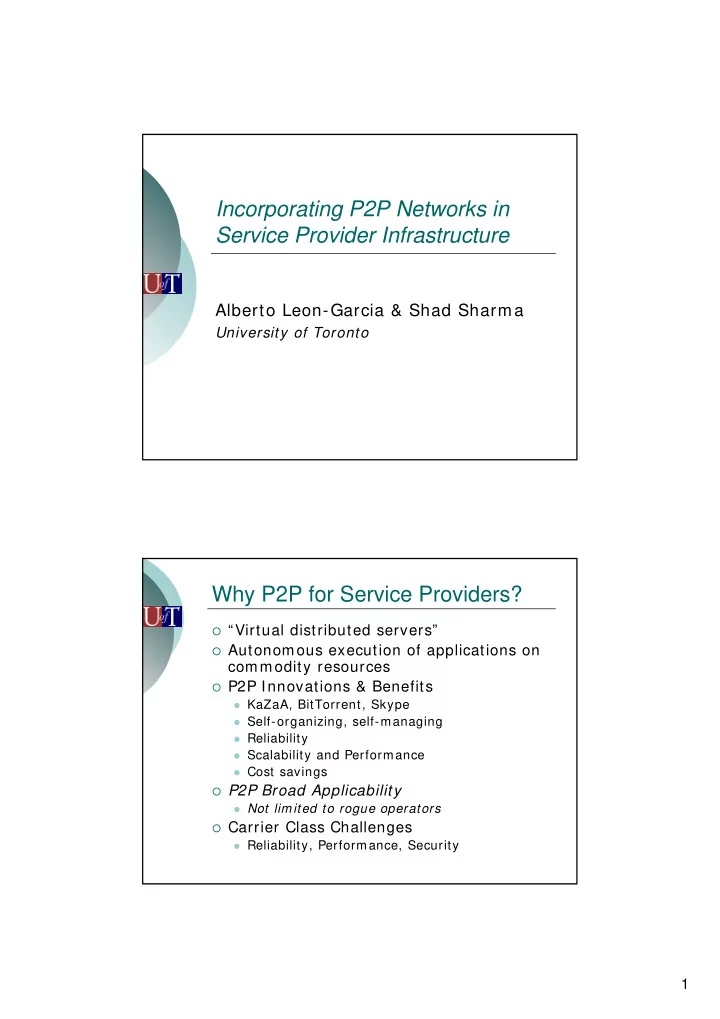

Incorporating P2P Networks in Service Provider Infrastructure Alberto Leon-Garcia & Shad Sharma University of Toronto Why P2P for Service Providers? � “Virtual distributed servers” � Autonomous execution of applications on commodity resources � P2P Innovations & Benefits � KaZaA, BitTorrent, Skype � Self-organizing, self-managing � Reliability � Scalability and Performance � Cost savings � P2P Broad Applicability � Not limited to rogue operators � Carrier Class Challenges � Reliability, Performance, Security 1
Introduction Overlay Topology � Application layer routing � Nodes maintain logical neighbours to whom they forward messages � � P2P Applications Content Delivery � Lookups and Search � Service Virtualization � � E.g. P2P HTTP server Distributed Hashing � Hash table � Defines set of buckets that hold objects � Hash function � Distributes objects into buckets � Objects distributed “uniformly” among buckets � Distributed Hash Table � Nodes are the buckets that store objects � Objects: files/ resources/ things you want to find/ store � Structured overlays well suited to providing DHT services � Predefined positions assigned to peers � Peers assigned hash values (buckets) 2
Introduction Unstructured Overlays Newscast + Robust, reliable, fast Epidem ic protocol based on insertion and removal gossiping – Broadcast based search Montressor O(m th root(n)) search time Dual layer approach: Newscast O(m x n) search messages substrate Structured Overlay Chord + Fast & efficient DHT search Structured DHT capable overlays O(log B (n)) search time Rigid finger tables O(log B (n)) search messages Routing table m aintenance Kademlia required Loosely consistent DHT overlay – Not robust under churn Relaxed finger tables Hybrid Overlay TrebleCast + Fast & efficient DHT search + Robust, reliable, fast insertion and removal + Resilient to churn TrebleCast (1) Peers inserted in order in � spiral-like fashion 80 49 50 51 52 53 54 55 56 Spiral - Notion of layers: � Provides data redundancy � 79 48 25 26 27 28 29 30 57 Data stored at each layer � 78 47 24 9 10 11 12 31 58 Peers maintain 4 neighbours: � In, out, left, right � 77 46 23 8 1 2 13 32 59 Successor: � 76 45 22 7 0 3 14 33 60 Peer responsible for replacing a � failed peer Successor moves “inwards” � 75 44 21 6 5 4 15 34 61 (closer to core) 74 43 20 19 18 17 16 35 62 Layer indicative of peer � reliability 73 42 41 40 39 38 37 36 63 Peers closer to core � considered more reliable 72 71 70 69 68 67 66 65 64 3
TrebleCast (2) Dual layer approach: � Newscast substrate � Grid superstructure � � Adaptable to churn: Superstructure repaired through � gossip messages exchanged at Newscast substrate Fast adaptive search: � Search messages exchanged at � superstructure layer Lookups under static conditions: � O(log B (n)) Graceful search degradation � under increasing churn � Flexible data storage policy: Choose location of stored data (at � core for instance) Permits flexibility allowing data � redundancy and load balancing Robustness and reliability: � Build overlay around core of � reliable server-like peers Implementation � TrebleCast implemented in Java � Currently used for SIP virtualization � May implement any < key, value> pair storage based mechanism � Register, store, retrieve, delete: O(log(n)) time � TrebleCast simulator implemented in Java � P2P Monitor implemented in Java � Monitors peers in a P2P network � Allows basic interaction with peers through virtual console 4
Pareto Turnover High Death Rate Reliable peers � move to overlay core Core “protected” � from churn Improved search � time (less routing table maintenance) Low Death Rate Fast Adaptive Search 5
Static Search Comparison Chord Churn Search Comp. Search Time vs. Churn Rate for Chord Networks of Mean Size 10000 (16384 max) 55 Aggressive repair � Exponential Lifetime mechanism Pareto Lifetime 50 implemented to maintain Chord 45 structure 40 Average Search Time (# of Hops) 35 Search degrades � exponentially as 30 Churn rate increases past 10 25 peers/ sec 20 15 10 5 -1 0 1 2 3 10 10 10 10 10 Churn Rate (Arrival Rate - peers/sec) 6
TrebleCast Churn Search Comp. Search Time vs. Churn Rate for TrebleCast Networks of Mean Size 10000 9 TrebleCast search � Exponential Lifetime degrades under Pareto Lifetime Exponential Lifetime w/ Bootstrap Server exponential 8 lifetime distribution 7 Average Search Time (# of Hops) Search remains � almost constant 6 under Pareto lifetime distribution 5 Note: Storage � 4 policy chosen so that a core set of 3 reliable peers are responsible for storage 2 -1 0 1 2 3 10 10 10 10 10 Churn Rate (Arrival Rate - peers/sec) Conclusions � Treblecast for service provider setting � Resilient to churn � Fast adaptive search: O(log(n)) � Inherent support for data redundancy � Flexible data storage & retrieval policy 7
Recommend
More recommend